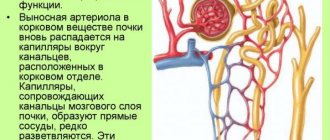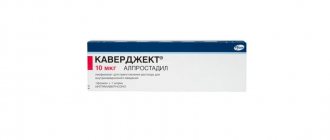Pharmacological properties of the drug Theotard
Theophylline is a bronchodilator. By relaxing the smooth muscles of the bronchi, it increases the flow of air through the bronchi and thus improves breathing. Because theophylline improves bronchial mucus transport (ciliary epithelial clearance) by increasing mucus and surfactant secretion, it improves expectoration. The anti-inflammatory effect of theophylline consists of inhibiting the proliferation of T-lymphocytes, inhibiting the secretion of cytokines (for example, interleukin-2, tumor necrosis factor), and the activity of eosinophils, macrophages and mast cells. These effects lead to a weakening of inflammation of the bronchial mucosa. Theophylline also affects the smooth muscles of the coronary arteries, blood vessels of the muscles and kidneys, relaxes the muscles of the uterus, cardioesophageal sphincter and bile ducts. Theophylline increases right ventricular ejection fraction, increases cardiac output, decreases pulmonary vascular resistance, and decreases pulmonary hypertension. Theophylline stimulates the respiratory center, increases contraction of the diaphragm and respiratory muscles, increases diuresis, and increases the secretion of catecholamines by the adrenal glands. The capsules contain granules that gradually release theophylline to prevent sudden increases or decreases in its concentration. Theophylline is completely absorbed from the gastrointestinal tract. The highest concentrations in the blood are achieved 7 hours after administration, and steady-state concentrations are achieved within 2-3 days of regular use. Theophylline is distributed to all organs and body fluids; metabolized in the liver. One of its metabolites (3-methylxanthine) also has a bronchodilator effect. Theophylline and its metabolites are excreted by the kidneys. The half-life of theophylline in people who do not smoke is 7–9 hours. In smokers, as well as in children, this time decreases, and in people with impaired liver function and heart failure, it increases.
pharmachologic effect
Theotard is theophylline (a xanthine derivative) in pellet form. Theophylline is a phosphodiesterase inhibitor, increases the accumulation of c-AMP in tissues, blocks adenosine (purine) receptors; reduces the flow of calcium ions through the channels of cell membranes, reduces the contractile activity of smooth muscles. Relaxes the muscles of the bronchi, blood vessels (mainly the vessels of the brain, skin and kidneys); has a peripheral vasodilating effect, increases renal blood flow, and has a moderate diuretic effect. Stabilizes the mast cell membrane, inhibits the release of mediators of allergic reactions. Increases mucociliary clearance, stimulates contraction of the diaphragm, improves the function of the respiratory and intercostal muscles, and stimulates the respiratory center. By normalizing respiratory function, it helps saturate the blood with oxygen and reduce the concentration of carbon dioxide; stimulates the breathing centers. Strengthens ventilation of the lungs in conditions of hypokalemia. It has a stimulating effect on the activity of the heart, has a positive inotropic and chronotropic effect on the heart, increases coronary blood flow and myocardial oxygen demand. Reduces the tone of blood vessels (mainly those of the brain, skin and kidneys). Reduces pulmonary vascular resistance, lowers pressure in the pulmonary circulation. Increases renal blood flow and has a moderate diuretic effect. Expands extrahepatic bile ducts. Inhibits platelet auregation (suppresses platelet activating factor and PgE2 alpha), increases the resistance of red blood cells to deformation (improves the rheological properties of blood), reduces thrombus formation and normalizes microcirculation.
Substituted release of the active substance from extended-release capsules ensures that the therapeutic level of theophylline in the blood is achieved 3-5 hours after administration and is maintained for 12 hours, so that effective concentrations of theophylline in the blood during the day are maintained when taking the drug 2 times a day.
The bronchodilator effect of Theotard develops gradually, so the drug is not prescribed for the relief of emergency conditions.
Use of the drug Theotard
The dose is set individually depending on age, body weight and metabolic characteristics. The usual dose for adults and adolescents weighing 40 kg is 350 mg theophylline 2 times a day. The usual dose for children over 6 years of age and weighing 20 kg, for adolescents is 200 mg theophylline 2 times a day. Patients with nocturnal asthma or sleep-disordered breathing may take a single dose of Theotard at night. On average, a daily dose of 400 to 700 mg of Theotard is sufficient. It is recommended to take the first dose of Theotard in the evening at night. The drug is used after meals with plenty of water. Capsules should be swallowed whole without chewing. The effectiveness of treatment and tolerability of theophylline should be determined on the 3rd day of treatment. If the effectiveness is satisfactory, treatment is continued with the prescribed dose, and if the effectiveness is unsatisfactory, the dose is increased. If side effects occur, reduce the dose. The dosage of theophylline is determined based on clinical effect, serum theophylline concentration and possible side effects. The desired therapeutic concentration of theophylline in serum is from 55 to 110 μmol/L (10–20 mg/L). Therapeutic serum theophylline concentrations are determined in the laboratory. Accurate theophylline concentrations are obtained by drawing blood for analysis 4 hours after the morning dose in a patient taking Theotard twice daily and 12 hours after the evening dose in a patient taking a concurrent daily dose of Theotard. The duration of treatment depends on the course of the disease.
Release form and composition
The dosage form of Teotard is long-acting capsules: hard gelatin, size No. 2 or No. 1 (200 or 350 mg, respectively); body – dark green, transparent; cover – dark green, opaque; The capsules contain white pellets (10 pieces in blister packs, 3 or 4 packs in a cardboard box).
Composition of 1 capsule:
- active substance: theophylline – 200 or 350 mg;
- auxiliary components: talc, dibutyl phthalate, anhydrous colloidal silicon dioxide, povidone, ammonium methacrylate copolymer type B, ammonium methacrylate copolymer type A;
- shell: gelatin, titanium dioxide (E171), quinoline yellow dye (E104), indigo carmine dye (E132).
Side effects of the drug Theotard
At the beginning of treatment, mild and temporary side effects may occur, such as headache, increased excitability, irritability, dizziness, insomnia, severe tachycardia and/or an unpleasant feeling of heartbeat (fluttering), abdominal pain, nausea, vomiting, diarrhea and allergic reactions. If the concentration of theophylline in the blood serum exceeds the therapeutic concentration (in hypersensitive patients even earlier), the following side effects may occur: sleep disturbance, large volume of urine excreted, repeated vomiting, tremor, hyperthermia, delirium, heart rhythm disturbances (tachyarrhythmia), sharp decrease Blood pressure and muscle cramps. During treatment with theophylline, the concentration of potassium in the blood serum may decrease (hypokalemia), and the concentration of calcium, creatinine, sugar and uric acid salts may increase (hypercalcemia, hyperglycemia, hyperuricemia).
Pharmacokinetics
After oral administration, Theotard is almost completely absorbed, bioavailability is 88-100%. Theotard extended-release capsules ensures the maintenance of a uniform level of theophylline in the blood serum for 12 hours.
After a single dose of 350 mg of the drug, its Cmax in plasma is reached within 7 hours, which is 4.4 μg/ml. The therapeutic concentration is reached after a few days and is 8-20 mcg/ml. Plasma protein binding is about 60%. Penetrates the placental barrier and is found in breast milk. Metabolized in the liver (90%) with the participation of several cytochrome P450 enzymes (the most important CYP1A2). Main metabolites: 1,3-dimethyluric acid and 3-methylxanthine.
Excretion of metabolites by the kidneys along with 7-13% of unchanged active substance (in children - 50%).
T1/2 in non-smoking patients is 7-9 hours. In smokers it is significantly shorter - 4 - 5 hours. In patients with cirrhosis of the liver, heart failure, renal failure and in patients with alcoholism, T1/2 is prolonged. Total clearance is reduced in patients with high fever, severe respiratory failure, in patients with liver failure or chronic heart failure (CHF), with viral infections, in patients over 55 years of age.
Special instructions for the use of the drug Theotard
Theotard should be prescribed with caution and only when urgently necessary to patients with unstable angina, heart disease, when tachyarrhythmic disturbances of the heart rhythm are noted, patients with hypertension (arterial hypertension), impaired renal and liver function, porphyria, as well as patients with peptic ulcer disease. history and patients over 60 years of age. The dose of theophylline should be reduced in patients with heart failure, impaired liver function (especially patients with cirrhosis of the liver), with a reduced concentration of oxygen in the blood (hypoxemia), patients with pneumonia, viral infectious diseases (especially influenza). Theophylline can change some laboratory parameters: increase the amount of fatty acids in the blood plasma and increase the level of catecholamines in the urine. During pregnancy and breastfeeding . Theophylline crosses the placenta and is excreted in breast milk. During pregnancy, you can take the drug only if the positive effect for the mother outweighs the risk for the fetus. In pregnant women, serum theophylline concentrations should be determined more frequently and the dose adjusted accordingly. Theophylline should be avoided late in pregnancy as it may inhibit uterine contractions. Breast-feeding women should monitor the infant for theophylline hypersensitivity reactions, agitation, or sleep problems and seek medical advice. Impact on the ability to drive vehicles and operate other machinery. Some side effects (such as dizziness) may affect your ability to drive or operate machines. Patients should be advised not to drive or operate hazardous machinery until they are confident they can tolerate treatment.
ATTENTION!
The information on the page you are viewing is created for informational purposes only and does not in any way promote self-medication. The resource is intended to provide healthcare workers with additional information about certain medications, thereby increasing their level of professionalism. The use of the drug “ Theophylline ” requires consultation with a specialist, as well as his recommendations on the method of use and dosage of the medicine you have chosen.
Source: allmed.pro
Drug interactions Theotard
During treatment with Theotard, you should not consume alcohol, large amounts of food and drinks that contain methylxanthine (coffee, tea, cocoa, chocolate, Coca-Cola), drugs related to theophylline (caffeine, theobromine, pentoxifylline), as these substances may increase stimulating effect of theophylline on the central nervous system. The effect of theophylline may be enhanced with simultaneous use of allopurinol, cimetidine, disulfiram, phenylbutazone, fluvoxamine, fluoroquinolones, furosemide, imipenem, interferon alpha, isoniazid, calcium antagonists, lincomycin, macrolides, mexiletine, paracetamol, pentoxifylline, oral contraceptives, probenecid, propafenone, pro pranolol, ranitidine, tacrine, thiabendazole, ticlopidine, viloxazine, or influenza vaccine. In patients who are taking one or more of the above drugs in parallel with theophylline, the concentration of theophylline in the blood serum should be monitored and the dose reduced if necessary. When taking ciprofloxacin in combination, the dose of theophylline should be reduced by at least 60%, and when taking enoxacin simultaneously, by 30%. The effect of theophylline may be reduced by concomitant use of antiepileptic drugs (for example, phenytoin, carbamazepine, primidone), barbiturates (especially phenobarbital and pentobarbital), isoprenaline, magnesium hydroxide, moracizine, rifampicin, ritonavir or sulfinpyrazone. The effect of theophylline may also be lower in smokers. In patients who are taking one or more of the above drugs concomitantly with theophylline, the concentration of theophylline in the blood serum should be monitored and the dose increased if necessary. Theophylline may enhance the effect of β-adrenergic agonists, diuretics and reserpine. Theophylline may reduce the effectiveness of adenosine, lithium carbonate and beta-adrenergic antagonists. The simultaneous use of theophylline and β-adrenergic receptor antagonists should be avoided, as theophylline may lose its effectiveness. Halothane anesthesia can cause serious cardiac arrhythmias in patients taking theophylline. During treatment with theophylline, hypokalemia may occur, especially with combined treatment with α-adrenergic receptor agonists, thiazide diuretics, furosemide, corticosteroids, and also with hypoxemia; Therefore, it is recommended to periodically check serum potassium levels.
Overdose
Symptoms:
decreased appetite, pain in the stomach, diarrhea, nausea, vomiting (including blood), gastrointestinal bleeding, tachypnea, facial skin flushing, tachycardia, ventricular arrhythmias, insomnia, motor agitation, anxiety, photophobia, tremor, convulsions. In severe poisoning, epileptoid seizures may develop (especially in children without any warning signs), hypoxia, metabolic acidosis, hyperglycemia, hypokalemia, decreased blood pressure, skeletal muscle necrosis, confusion, renal failure, with myoglobinuria.
Treatment:
drug withdrawal, gastric lavage, administration of activated charcoal, laxatives, intestinal lavage with a combination of polyethylene glycol and electrolytes, forced diuresis, hemosorption, plasma sorption, hemodialysis (low effectiveness, peritoneal dialysis is ineffective), symptomatic therapy (including metoclopramide and ondansetron - when vomiting). If convulsions occur, maintain airway patency and administer oxygen therapy. To stop a seizure - intravenous diazepam, 0.1-0.3 mg/kg (but not more than 10 mg). For severe nausea and vomiting, use metoclopramide or ondansetron (iv).
Overdose of the drug Theotard, symptoms and treatment
It is noted if the concentration of theophylline in the blood serum exceeds 110 µmol/l. Clinical signs of overdose include tremor, nausea, vomiting, diarrhea, delirium, and in especially severe cases, heart rhythm disturbances (tachyarrhythmia), a sharp decrease in blood pressure and muscle cramps. Tachyarrhythmias and seizures may occur suddenly, without the warning symptoms typical of a minor overdose (eg, nausea and vomiting). In most cases, it is sufficient to reduce the dose or temporarily stop using Theotard. Hypotension, restlessness, tremors, delirium, seizures, and more severe cardiac arrhythmias may occur after taking excessive amounts of capsules. In such cases, serum theophylline concentrations should be immediately determined and the dose of Theotard reduced accordingly. Treatment: gastric lavage and use of activated carbon. It is necessary to monitor the patient's condition, especially blood pressure, heart rate, respiration and the concentration of theophylline and potassium in the blood serum. In severe cases, the elimination of theophylline can be accelerated using hemoperfusion or hemodialysis.
Contraindications
Absolute:
- arterial hypo- or severe hypertension;
- acute myocardial infarction;
- hemorrhagic stroke;
- severe arrhythmias;
- retinal hemorrhage;
- epilepsy;
- peptic ulcer of the stomach and duodenum in the acute stage, gastritis with high acidity, bleeding from the gastrointestinal tract;
- age up to 6 (200 mg capsules) or up to 12 years (350 mg capsules);
- individual intolerance to the components of the drug, including hypersensitivity to other xanthine derivatives (pentoxifylline, caffeine, theobromine).
Relative (Theotard's prescription requires caution in the presence of the following diseases/conditions):
- uncontrolled hypothyroidism or thyrotoxicosis;
- widespread vascular atherosclerosis;
- porphyria;
- increased convulsive readiness;
- severe hepatic/renal dysfunction;
- unstable angina (severe coronary insufficiency);
- chronic heart failure;
- recent bleeding from the gastrointestinal tract;
- hypertrophic obstructive cardiomyopathy;
- frequent ventricular extrasystole;
- gastroesophageal reflux;
- prostatic hypertrophy;
- prolonged hyperthermia;
- aggravated medical history of gastric and duodenal ulcers;
- pregnancy and lactation (pregnant women are prescribed Teotard only after assessing the ratio of expected benefit to possible risk; if possible, it is recommended to monitor the serum concentration of theophylline more often and adjust the dose; in the third trimester of pregnancy, the use of the drug is not recommended, since therapy can lead to a decrease in uterine contractility. Breastfeeding women are advised to strengthen control over the condition of the newborn; in cases of sleep disturbances and irritability, it is recommended to consult a specialist);
- children and elderly (from 60 years old) age.



